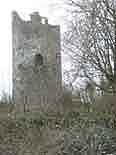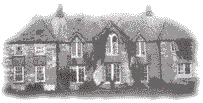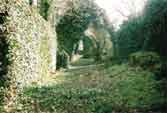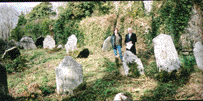
 A Geraldine Castle which was marked on Batiste Boazio’s Map of 1598.
A Geraldine Castle which was marked on Batiste Boazio’s Map of 1598.
The building has three storeys and one entrance door in the western side.
It measures 21 feet 6 inches in length by 20 feet 6 inches in width and its height is approximately 50 feet.
It was originally part of the estate of the Earl of Shannon.
In the 1920’s & 1930’s it was used as a meeting place after Sunday Mass.
This school was built on Church grounds near the castle and was paid for out of parish funds. The walls were stone and mortar and the roof was thatched. It consisted of one room measuring 50 feet 4 inches in length and 13 feet 8 inches in width. It was furnished with one large desk, one small desk and seven large forms.
It could accommodate eighty pupils. Classes were held six days a week from 9 am to 4 pm and religious instruction classes were held on Sundays from 9 a.m. to 12 noon, except during Mass which was held in the Church here near the castle.
An Inspectors observations and suggestion book from 1856 onwards until its closure in 1898 has survived. It gives an account of the District Inspectors reports when he visited the school on a twice yearly basis reporting on:
(I) Each Class
(ii) Mode of Teaching
(iii) Discipline and Order
(iv) School Accounts
(v) School room & Premises
(vi) Supply of Books & Apparatus
(vii) Industrial Training
(viii) Observance of former suggestions.
The final Inspectors report for this school dated 31st March 1898 in which the building was described as a ‘wretched hovel’.
 The original charter to found a school at Curragrine was given by King George II in 1735. Over the door of the charter school house on a black marble stone read an inscription,
The original charter to found a school at Curragrine was given by King George II in 1735. Over the door of the charter school house on a black marble stone read an inscription,
"In the year of Our Lord 1748 this charter house was erected at the charge of the Incorporated Society on ground given by the right honourable Henry Boyle".
The aim of the school is set out in the charter as follows: "This school is for the instruction of Roman Catholics and other poor natives of Ireland in writing, english and arithmetic, in husbandry and housewifery or in trades and other occupations, in scripture and in the principles of the Protestant Established Religion."
In 1808 commissioners from the Board of Education visited the school and found thirty four healthy and well looking boys in a building built to accommodate forty children.
It was well situated near a main road about a mile from the town of Castlemartyr.
It was a very good looking building with wings enclosed in a spacious courtyard and shaded with trees. At either side of the main entrance hall there was a dining room and a school room, each twenty two feet square. The school contained a 'most excellent dormitory, thirty eight feet long and twenty two feet wide.'
One wall of the church is still standing near the western side of the castle.
There is reference made to this church in the report of Bishop Matthew McKenna of Cloyne in 1785. The church was attached to the Parish of Ballyoughtra at that time.
The Church was interdicted by Bishop Coppinger in 1799, because the local people put up a notice near the church refusing to pay tithes, however the matter was resolved and Mass resumed the following Sunday.
 The early evidence of the existence of a town or "vill" in the vicinity of Castlemartyr is to be found in the Pipe Roll Of Cloyne, a list of all the lands, with their valuations, held by the feudal Bishop of Cloyne.
The early evidence of the existence of a town or "vill" in the vicinity of Castlemartyr is to be found in the Pipe Roll Of Cloyne, a list of all the lands, with their valuations, held by the feudal Bishop of Cloyne.
There had been two adjoining medieval parishes, Caherultan and Ballyoughtera, and both are known to have been in existence by, at least, 1300, when Ballyoughtera was valued at 5 marks and Caherultan at 3 marks.
Ballyoughtera also known as Brazierstown is said to have become an industrial village of some note during the middle ages in which vicinity iron was the only metal known to exist.It is likely that Ballyoughtera Church was a stop off point on the ancient pilgrim's path known as Bóthar Na Naomh. The path started at St. Carthage's of Lismore, and went through Dungourney, on to Ballyoughtera, to St. Colman's in Cloyne on to Ballinacurra, to Great Island and finishing in Cork.
 St. Callachan was the patron saint of the old parish of Ballyoughtera, according to Bishop Matthew McKenna's visitation notes which were written in 1785. Ballyoughtera is now part of the parish of Midleton.
St. Callachan was the patron saint of the old parish of Ballyoughtera, according to Bishop Matthew McKenna's visitation notes which were written in 1785. Ballyoughtera is now part of the parish of Midleton.
An excellent example of an Ice House is located approximately one mile from Ballintotas. Ice houses were designed to remain cold all the year round and were used extensively in Ireland from the late 17th century until well into the 19th century, when more advanced forms of refrigeration became available.
They were constructed adjacent to the 'great houses' - the local ice house was on the estate of Lord Shannon.
The present parish of Midleton consists of the union of four pre-reformation parishes namely Ballinacurra, Ballyspillane, Ballyoughtera and Inchinabacky.
The townlands of the Parish of Inchinabacky were listed in Griffith's Valuation of 1852 as being Bilberry, Churchtown North, Clashduff, Harrisgrove, Roxborough and Stumphill. These were located in the Barony
of Barrymore.
The first recorded reference available to the parish, is in Pope Nicholas' Taxation of 1291.
The Milltown Mills were flourishing in the mid 1800's. These mills were built about half a mile from the main Midleton to Youghal road, near Churchtown North and beside the Ballinona river.
The mills started to decline in the 1880's.
Click to Comment
RTÉ Radio 1- RTÉ 2fm
Lyric fm - Today fm
RTÉ Radió Na Gaeltachta
Cork's 96 fm -
Cork's 103 fm
Cork's Red fm - WLR fm
Weather
Area Map
Ballintotis OR Ballintotas?
Ballintotis Castle
Castlefield
National School 1825
Charter School
Old Catholic Church
Ballyoughtera
Icehouse
Inchinabacky
Milltown Mills

Services

E-mail us











